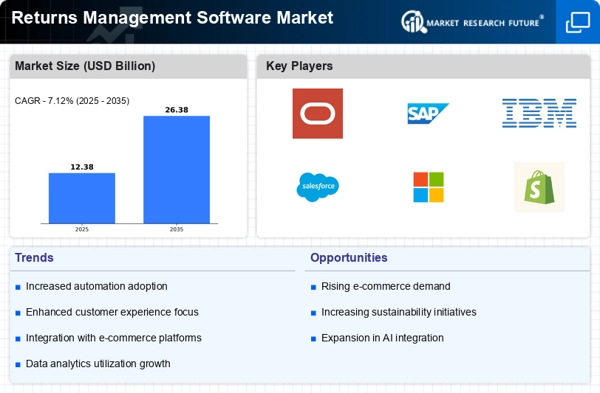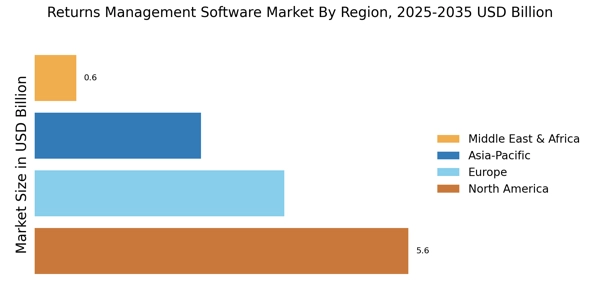The Returns Management Software Market is currently characterized by a dynamic competitive landscape, driven by the increasing need for efficient returns processes in e-commerce and retail sectors. Key players such as Oracle (US), SAP (DE), and Shopify (CA) are strategically positioning themselves through innovation and partnerships. Oracle (US) focuses on integrating advanced analytics into its returns management solutions, enhancing customer experience and operational efficiency. Meanwhile, SAP (DE) emphasizes its cloud-based offerings, which allow for seamless integration with existing enterprise systems, thereby streamlining returns processes. Shopify (CA) is leveraging its extensive e-commerce platform to provide tailored returns solutions for small to medium-sized businesses, indicating a shift towards more personalized service offerings. Collectively, these strategies contribute to a competitive environment that is increasingly centered on technological advancement and customer-centric solutions.
In terms of business tactics, companies are increasingly localizing their operations and optimizing supply chains to enhance responsiveness to market demands. The Returns Management Software Market appears moderately fragmented, with a mix of established players and emerging startups. This fragmentation allows for diverse offerings, yet the influence of key players remains substantial, as they set benchmarks for service quality and technological integration.
In August 2025, Oracle (US) announced a partnership with a leading logistics provider to enhance its returns management capabilities. This collaboration aims to streamline the returns process by integrating real-time tracking and analytics, which is expected to significantly reduce processing times and improve customer satisfaction. Such strategic moves indicate Oracle's commitment to leveraging partnerships to enhance its service offerings and maintain a competitive edge in the market.
In September 2025, Shopify (CA) launched a new feature that allows merchants to automate the returns process directly through their online stores. This innovation not only simplifies the returns experience for customers but also reduces the operational burden on merchants. By focusing on automation, Shopify (CA) is likely to attract more businesses looking for efficient solutions, thereby strengthening its market position.
In October 2025, SAP (DE) unveiled an upgraded version of its returns management software, incorporating AI-driven insights to predict return trends and optimize inventory management. This enhancement reflects SAP's focus on integrating cutting-edge technology into its offerings, which could provide clients with a significant advantage in managing returns more effectively. The strategic importance of this upgrade lies in its potential to transform how businesses approach returns, shifting from reactive to proactive management.
As of October 2025, the Returns Management Software Market is witnessing trends such as digitalization, sustainability, and AI integration, which are reshaping competitive dynamics. Strategic alliances are becoming increasingly vital, as companies seek to enhance their technological capabilities and service offerings. Looking ahead, competitive differentiation is likely to evolve from traditional price-based competition to a focus on innovation, technology integration, and supply chain reliability, suggesting a more sophisticated landscape where customer experience and operational efficiency take precedence.


















Leave a Comment